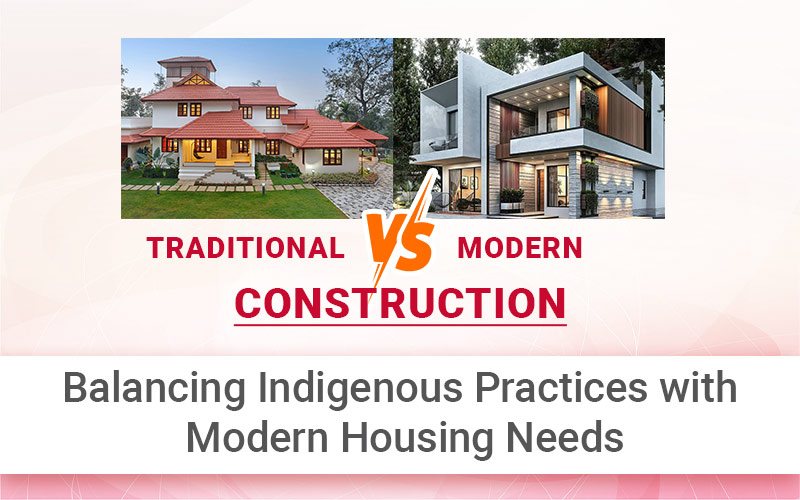Traditional vs. Modern Construction: Balancing Indigenous Practices with Modern Housing Needs
India has always been a land of architectural variety. From bamboo stilt houses in Assam to stone and timber Kath-Kuni homes in Himachal Pradesh, traditional building methods were more than just a way to have shelter. They were practical, sustainable, and deeply tied to culture and nature. These homes worked with the environment rather than against it.
But with rapid urbanization and rising population pressures, cities needed faster, stronger, and taller housing solutions. Reinforced concrete, steel frameworks, and prefabricated models became the norm. These innovations allowed India to build metros, skyscrapers, and large housing colonies at scale. However, they also raised new challenges like environmental impact, loss of cultural identity, and growing energy demands.
At XTech TMT Bars, we believe the real question isn’t whether to go traditional or modern. The answer lies in balance – blending the wisdom of indigenous practices with the reliability of modern technology.
Why Traditional Construction Still Matters
Traditional homes were designed with nature in mind:
●
Mud walls in Rajasthan kept homes cool in the desert heat.
●
Sloping roofs in Kerala helped during heavy monsoon rains.
● Bamboo stilt houses in Assam withstood both floods and earthquakes.
These structures were naturally energy-efficient, requiring no air conditioners or heaters. They also used local materials like bamboo, mud, stone and lime which were renewable, affordable and eco-friendly.
Kath-Kuni homes in the Himalayas flex during earthquakes, while bamboo absorbs flood shocks better than concrete. On top of that, traditional homes carried cultural identity, with courtyards, jali screens, and community spaces that made living warmer and more connected.
Why Modern Construction Took Over
Despite their beauty and eco-friendliness, traditional methods couldn’t keep pace with modern needs.
● Urban Scale & Speed: Cities required tall apartment buildings and offices, which mud or bamboo couldn’t support.
● Durability: Concrete and steel last longer with less maintenance.
● Standardization: Modern engineering follows safety codes for disaster protections.
● Aspirational Value: Concrete houses became symbols of progress and social status.
The use of concrete and TMT bars, made it possible for India to complete projects such as bridges, skyscrapers, metros and big housing colonies fast enough to meet the demand of the economy without compromising on safety.
The Problem with Modern Housing
Relying only on modern construction comes with its own challenges:
● Environmental Cost: Cement and steel production are huge contributors to CO₂ emissions.
● Thermal Inefficiency: Many glass-heavy high-rises trap heat, leading to higher energy bills.
●
Affordability: Rising costs of
steel, cement, and labor make housing expensive.
● Cultural Loss: Uniform high-rises erase architectural diversity.
● Safety Risks: When poor-quality steel or concrete is used, disasters like building collapses.
This is where materials like XTech TMT Bars play a crucial role, offering reliable strength, ductility, and corrosion resistance so that structures stay safe and durable even in harsh conditions.
The Hybrid Approach
The future of construction doesn’t lie in choosing between old and new, but in combining both.
Examples of Hybrid Practices:
● Climate-Sensitive Design with Modern Strength: Courtyards for airflow in apartments, jali screens for cooling and sloped roofs with advanced waterproofing.
● Upgraded Traditional Materials: Stabilized mud blocks, engineered bamboo, and rammed earth walls supported by TMT steel frameworks.
● Disaster-Resilient Hybrids: Dhajji Dewari timber frames reinforced with steel, bamboo structures strengthened with connectors and TMT reinforcements.
These approaches not only save energy but also keep cultural identity alive while ensuring safety.
The Role of XTech TMT Bars
At XTech TMT, we see ourselves as partners in building smarter, safer, and more sustainable homes. Our TMT bars offer:
● Earthquake resistance: High ductility absorbs seismic shocks, crucial for regions like Northeast India and Himachal.
● Corrosion resistance: Perfect for coastal and flood-prone areas where humidity weakens ordinary steel.
● High strength: Enables vertical construction with less material use.
● Longer life: Durable reinforcements reduce maintenance and rebuilding, cutting environmental impact.
By embedding these qualities into hybrid construction, XTech TMT Bars make it possible to honor tradition while meeting modern safety standards.
Policy, Education and Industry Collaboration
To make hybrid construction a success, all stakeholders must play a role:
●
Government: They can provide
schemes or incentives that make sustainable housing easier and more affordable.
●
Academia: Colleges and
researchers can try out local methods, test them, and show how they can fit
into today’s needs.
●
Industry: Companies must
spread awareness, promote safe practices, and show how strong materials can
support both traditional and modern designs.
●
Communities: Local masons and
carpenters can be trained to use both traditional skills and modern tools
together, preserving heritage while embracing innovation.
Conclusion
Therefore, the future of housing is not about Traditional vs. Modern but rather Traditional with Modern.
Indigenous practices remind us to live with nature, while modern engineering ensures safety, durability and scale. Together, they can redefine how India builds its homes - strong, sustainable, and culturally rooted.
At XTech TMT, we are proud to be part of this journey.














